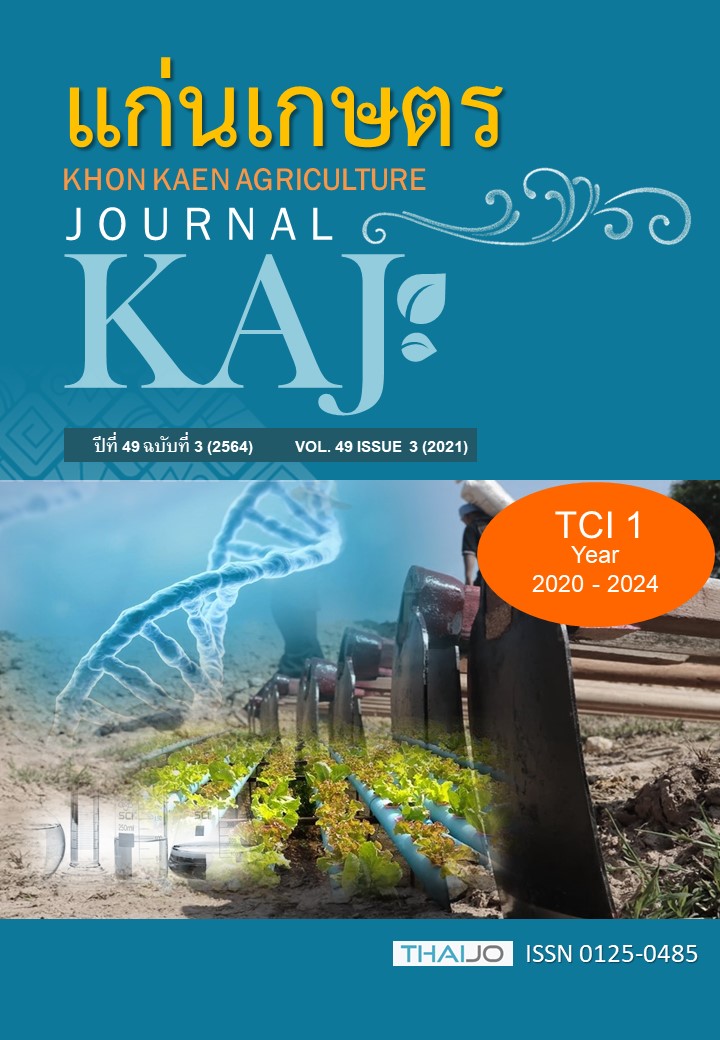Variations of phytoplankton in the lower part of the Tapee River Basin (TRB), Surat Thani Province, Thailand
Main Article Content
บทคัดย่อ
This paper illustrates phytoplankton variations in the lower part of the Tapee River Basin (TRB), Surat Thani Province, Thailand, including species composition, relative abundance, diversity indices, patterns of distribution, and assessing aquatic ecosystem or water conditions, as well as considering potential measures for aquatic resources management effectively. Spatial and temporal sampling was designed to collect data at five study stations one time a season (two days a time) during three different seasons: dry, early rainy and heavy rainy seasons from December 2017 to August 2018. In each study station, the samples were collected by water sampler at three sides of rivers with three different water depths. Univariate and multivariate analyses were used to evaluate the data. The findings showed that a total of 63 phytoplankton genera belonging to eight Divisions were found. Three dominant genera were Actinastrum spp., Spirulina sp. and Aulacoseira sp. An average abundance was 1,917.8 units/L which has tended to increase from upstream to downstream. Average values of Pielou’s evenness index (J') and Shannon-Wiener’s diversity index (H') were 0.58 and 2.41, respectively, which could be classified as the medium diversity and distribution levels. Overall of Applied Algal Research Laboratory Phytoplankton Score (AARL - PP score) was 6.6, showing that water quality condition was generally meso-eutrophic and moderately-polluted. Based on the findings of this study, it was recommended that the properly aquatic resources management to maintain effectively ecosystems and fish stocks should be conducted. For example, monitoring program to regularly assess water quality should be done throughout the year, and restocking native herbivorous fish species would be the best conducted at station 5, and during the dry season.
Article Details

อนุญาตภายใต้เงื่อนไข Creative Commons Attribution-NonCommercial-NoDerivatives 4.0 International License.
เอกสารอ้างอิง
APHA, AWWA and WPCP. 1989. Standard methods for the examination of water and wastewater. 17th Edition. American Public Health Association, Washington DC.
Begon, M., J.L. Harper, and C.R Townsend. 1990. Ecology: Individuals, Populations and Communities. Blackwell Scientific Publications, Oxford.
Bellinger, E.G., and D.C. Sigee. 2015. Freshwater Algae Identification and Use as Bioindicators. 2nd Edition. Wiley-Blackwell, New Jersey.
Clarke, K.R., and R.M Warwick. 1994. Change in marine community: an approach to Statistic analysis and interpretation. Plymouth Marine Laboratory, Plymouth.
Harper, J.L., and D.L. Hawksworth. 1994. Biodiversity: measurement and estimation. Philosophical Transactions of the Royal Society B: Biological Sciences. 345: 5-12.
Harris, G. 2012. Phytoplankton Ecology: Structure, Function and Fluctuation. Springer, Netherlands.
Hydro–Informatics Institute (Public Organization). 2012. Conducting data collection and analysis; Project to develop 25 river basin data warehouse systems and the Tapee River Basin flood modeling. Asdecon corporation co. ltd., Bangkok.
Kaewsrithong, C., W. Hirunchulha, and S. Rungruang, 2009. Species composition and distribution of plankton in the Tapee River. Available: https://tarr.arda.or.th/preview/item/yVuYFFnz2SsFSHp1SHiGi?keyword. Accessed Dec. 22, 2020.
Khan, T.A. 2003. Limnology of four saline lakes in western Victoria, Australia: Biological parameters. Limnologica. 33: 327-339.
Kumano, S. 2002. Freshwater red algae of the world. Biopress Limited, Bristol.
Laudee, P., and T.O. Prommi. 2011. Biodiversity and distribution of Trichoptera species along the Tapee River, Surat Thani Province, southern Thailand. Zoosymposia. 5: 279-287.
Molinero, J.C., F. Ibanez, S. Souissi, E. Bosc, and P. Nival. 2008. Surface patterns of zooplankton spatial variability detected by high frequency sampling in the NW Mediterranean: role of density fronts. Marine System. 69: 271–282.
Munk, P., B.W. Hansen, T.K. Nielsen, and H.A. Thomsen. 2003. Changes in plankton and fish larvae communities across hydrographic fronts off West Greenland. Plankton Resource. 25: 815–830.
Palmer, C.M. 1969. A composite rating of algae tolerating organic pollution. Phycology. 5:78-82.
Palmer, M.C. 1977. Algae and water pollution. Office of Research and Development, U.S. Environmental Protection Agency, Ohio.
Parmar, T.K., D. Rawtani, and Y.K. Agrawal. 2016. Bioindicator: the natural indicator of environmental pollution. Frontiers in life science 9: 110-118.
Peerapornpisal, Y., J. Pekkoh, D. Powangprasit, T. Tonkhamdee, A. Hongsirichat, and T. Kunpradid. 2007. Assessment of water quality in standing water by using dominant phytoplankton (AARL-PP Score). Journal of fisheries technology research. 1(1): 71-81.
Prescott, A. 1973. Algae of Western Great Lake Area. Brown Company Publishers, Iowa.
Pollution Control Department. 2016. Notification of Pollution Control Department: Types of water sources in the Tapee and Phum Duang Rivers. Available: http://hydrolaw.thaiwater.net. Accessed Dec. 22, 2020.
Purvis, A., and A. Hector. 2000. Getting the measure of biodiversity. Nature. 405: 212-219.
Rott, E., E. I. Silva, E.E. Enriguez, and S. Ingthamjitr. 2008. Phytoplankton community structure with special reference to species diversity in five tropical Asian water bodies. P. 81-120. In: F. Schiemer, D. Simon, U.S.
Amarasinghe, and J. Moreau. Aquatic ecosystems and development: Comparative Asian perspectives. Backhuys, Leiden/Margraf, Weikersheim Publishers.
Sakset, A. 2001. Primary production assessment for fishery resources management at Koa Leam Reservoir, Kanchanaburi Province. M.S. Thesis. Kasetsart University, Bangkok.
Sakset, A. 2011. Biophysical and Socio-economic assessment for fisheries management in the freshwater fishing area in Pak Phanang River Basin, Nakhon Si Thammarat Province. Ph.D. Thesis. Asian Institute of Technology. Pathumthani.
Sakset, A., N. Kaewrit, and C. Kaewsrithong. 2014. Assessing the water quality by AARL-PP score of dominant phytoplankton and BMWP(THAI) score of benthos in the Pak Panang river basin, Nakhon Si Thammarat Province. Thai Fisheries Gazette. 67(1): 29-42.
Tudorancea, C., R.H. Green, and J. Huebner. 1979. Structure, dynamics and production of benthic in Lake Manitoba. Hydrobiologia. 64(1): 59-95.
Wetzel, R.G. 2001.Limnology: Lank and river ecosystem, third edition. Academic Press. California.
Wikipedia. 2013. Biological monitoring working party. Available: http://en.wikipedia.org/wiki/Biological_monitoring_working_party. Accessed Dec. 22, 2020.
Williams, W.D. 1992. The biological status of Lake Corangamite and other lakes in western Victoria. A report to the Department of Conservation and Environment. Colac, Victoria.
Wilhm, J.L., and T.C. Dorris. 1968. Biological parameters of water quality criteria. Bioscience. 18: 477–481.
Whitton, B.A. 1975. River ecology. Blackwell Scientific Publishers, Oxford.
Wongrat, L. 1988. Phytoplankton. Section of Fishery Biology, Faculty of Fisheries, Kasetsart University, Bangkok.
Wikipedia. 2019. Tapi River (Thailand). Available: https://en.wikipedia.org/wiki/Tapi_River_(Thailand). Accessed Mar. 22, 2021.
Wikipedia. 2021. Phum Duang River. Available: https://en.wikipedia.org/wiki/Phum_Duang_River. Accessed Mar. 22, 2021.


